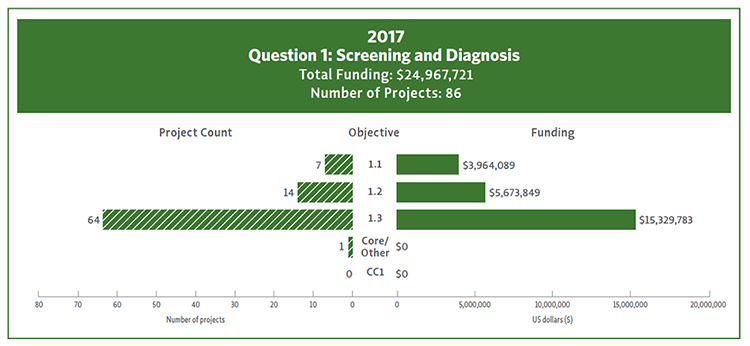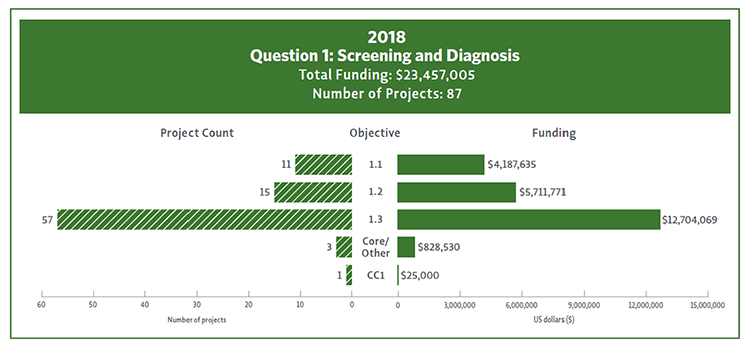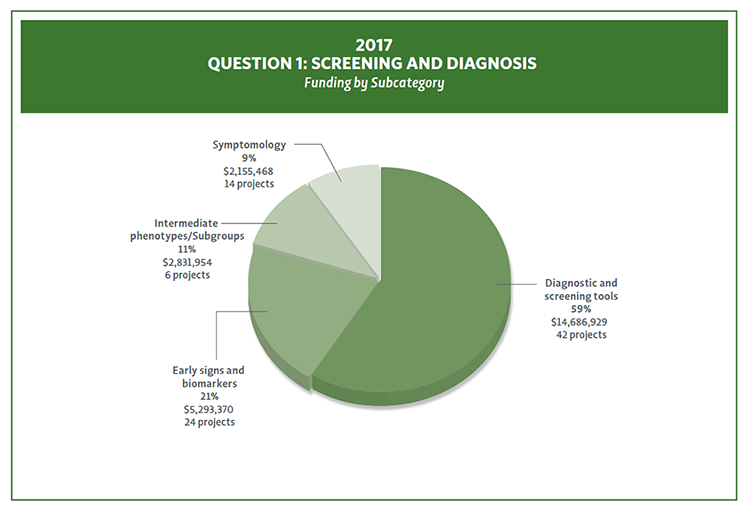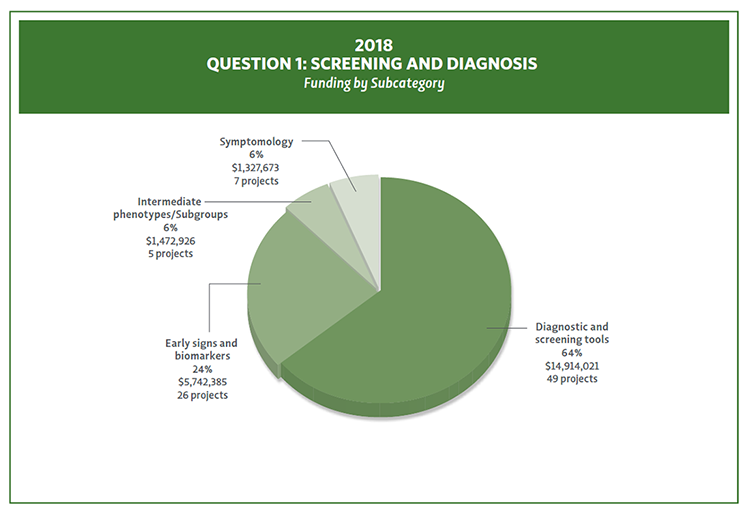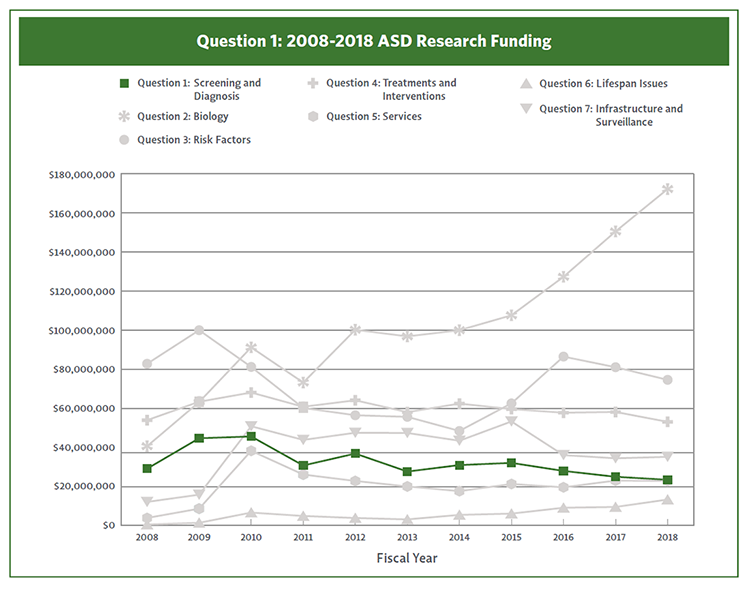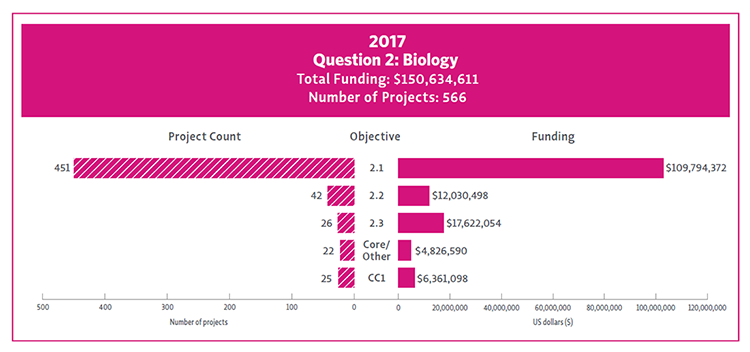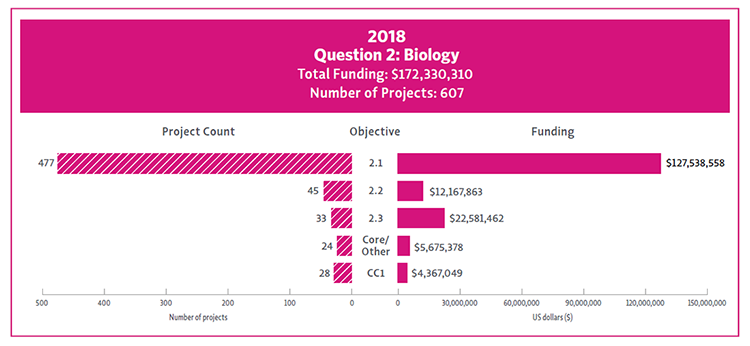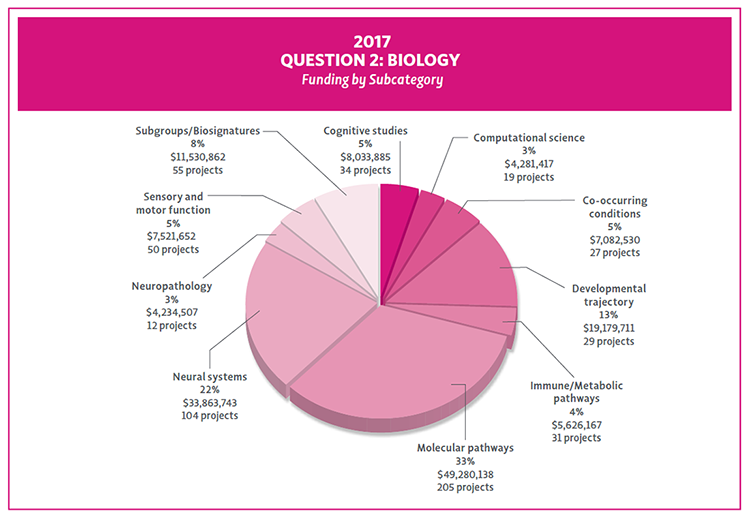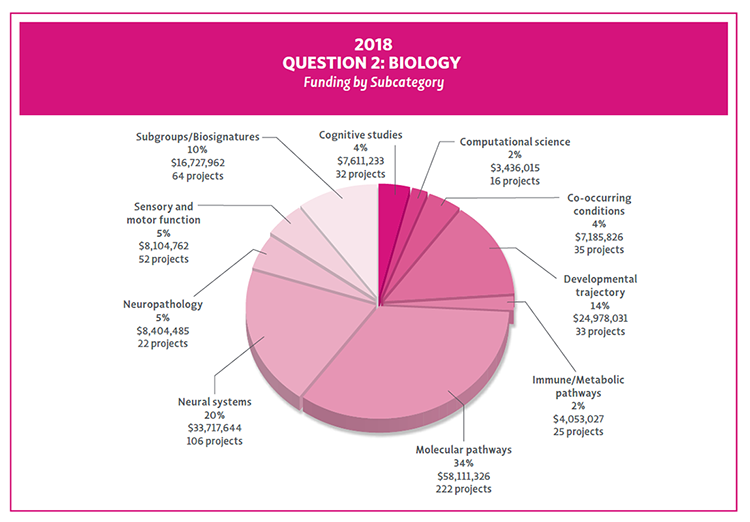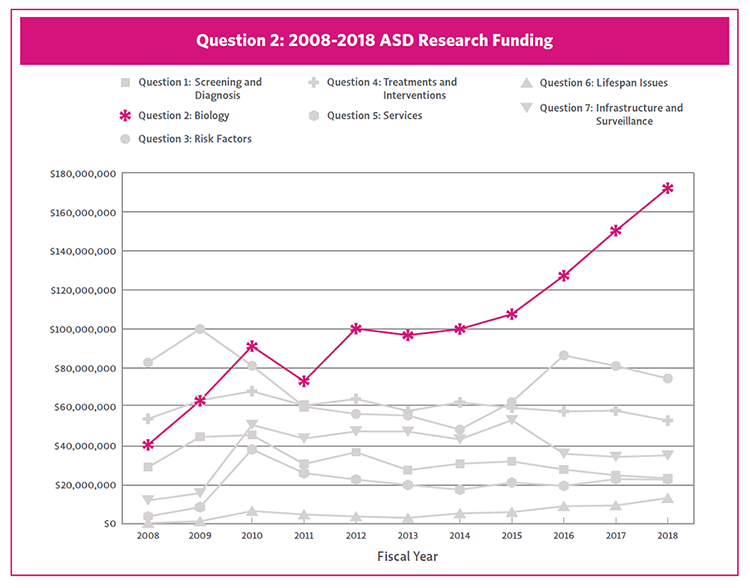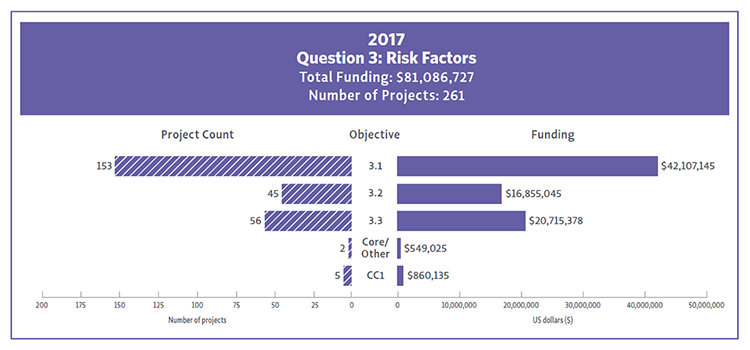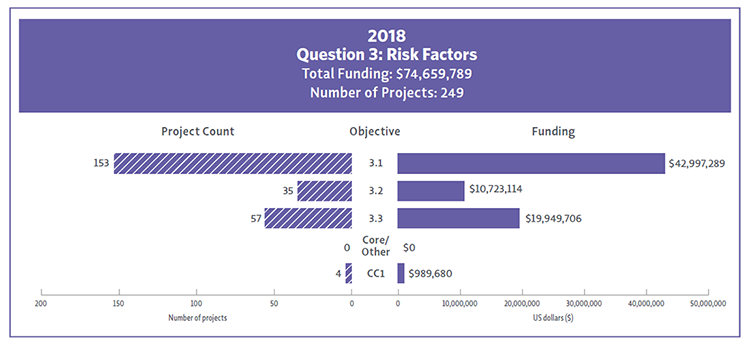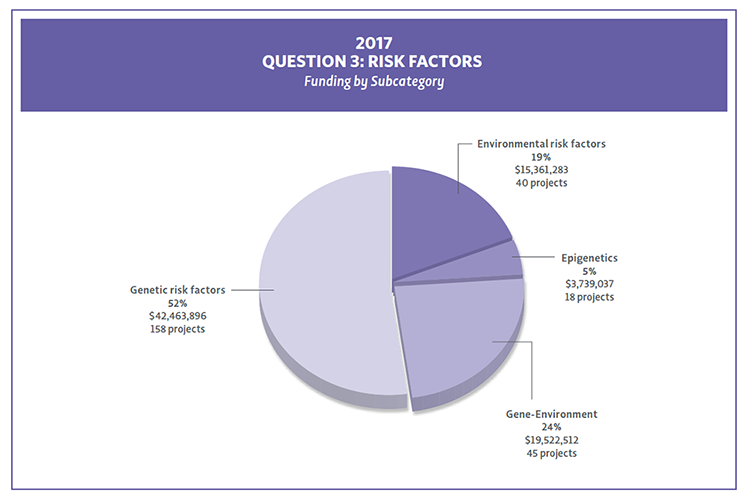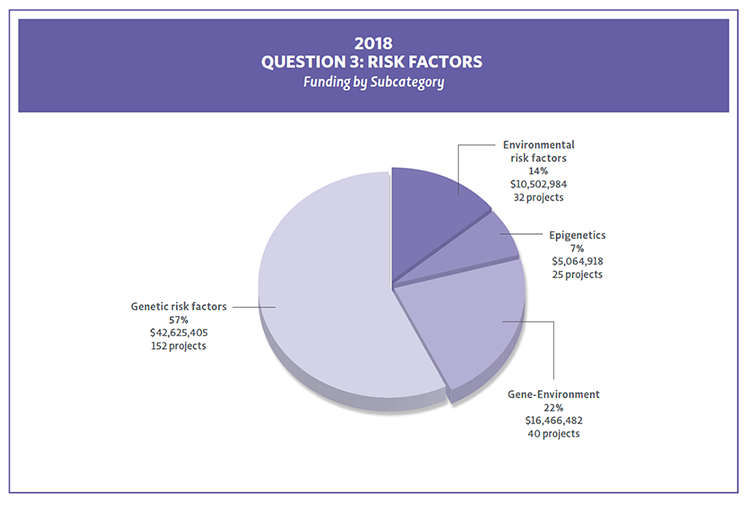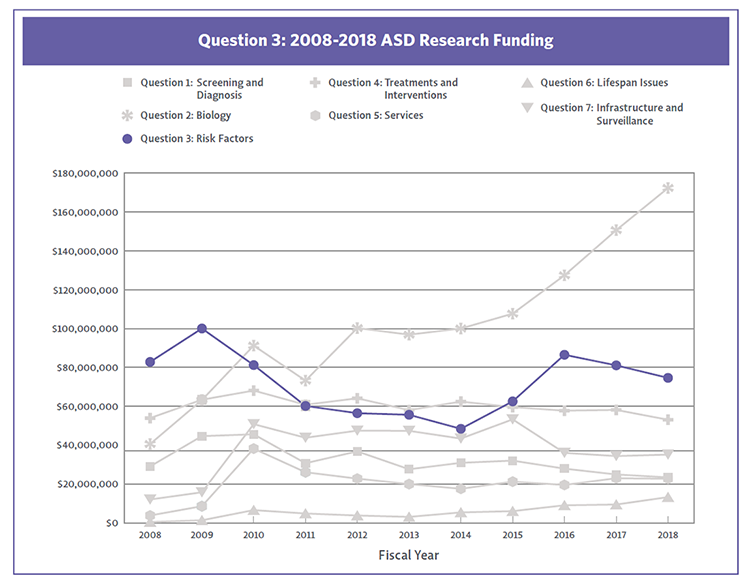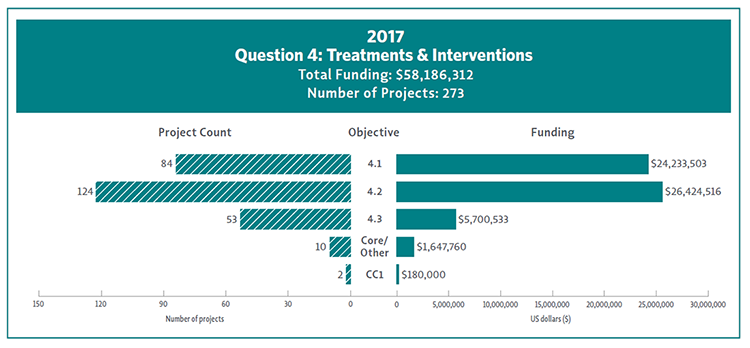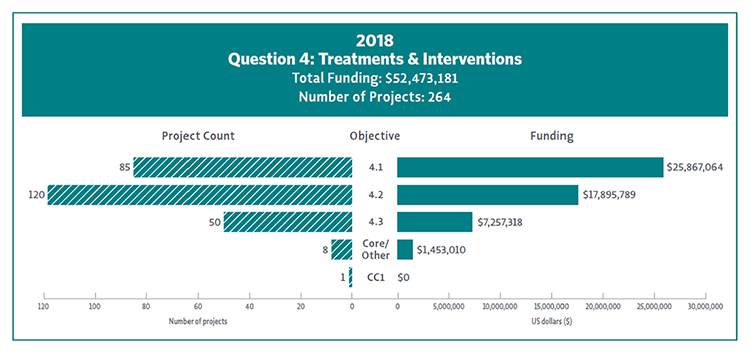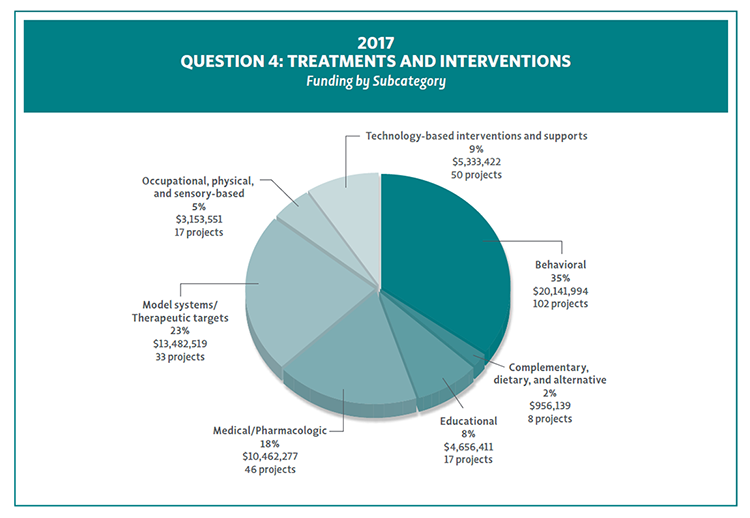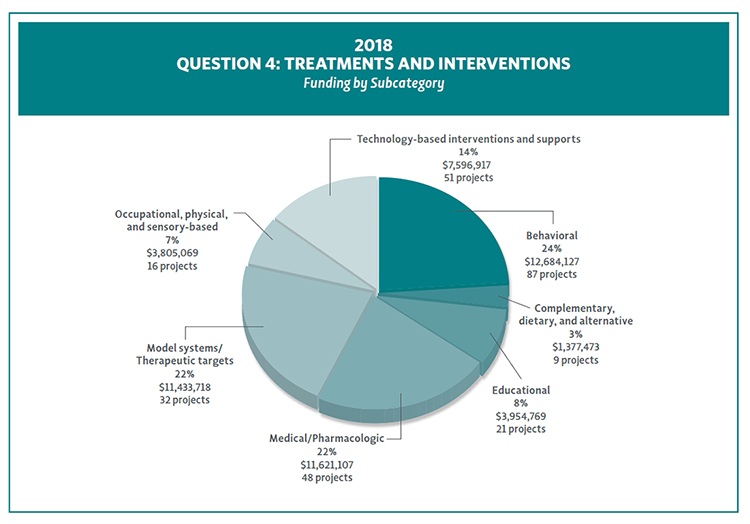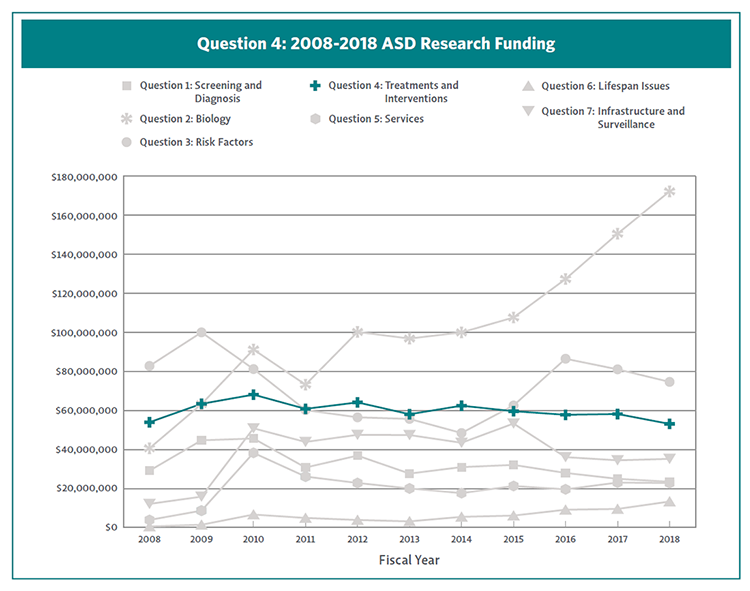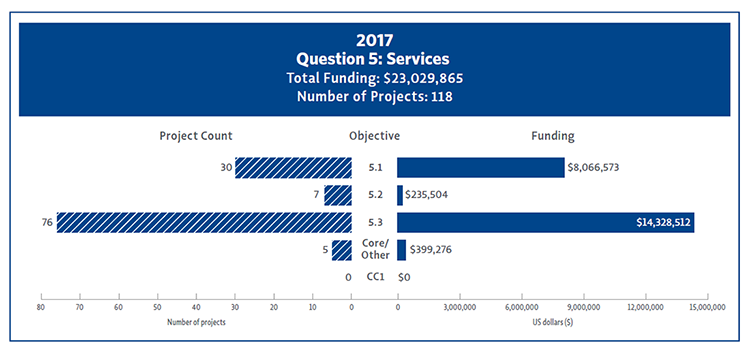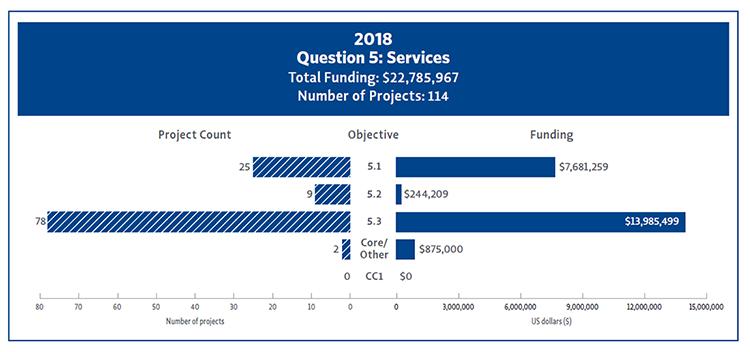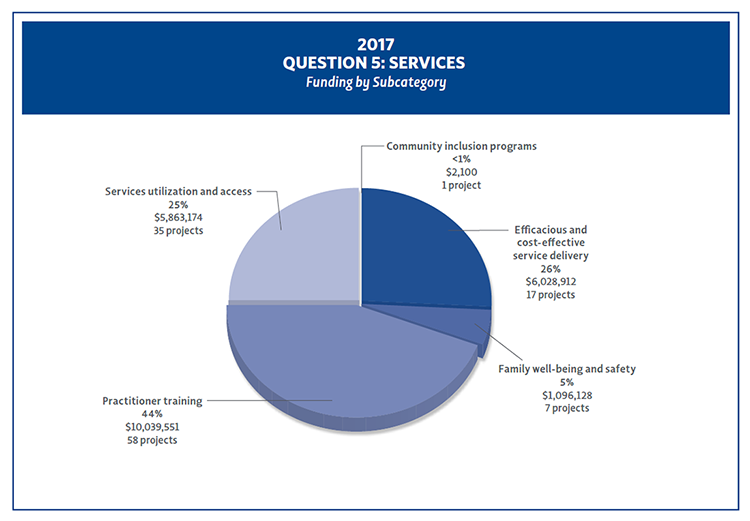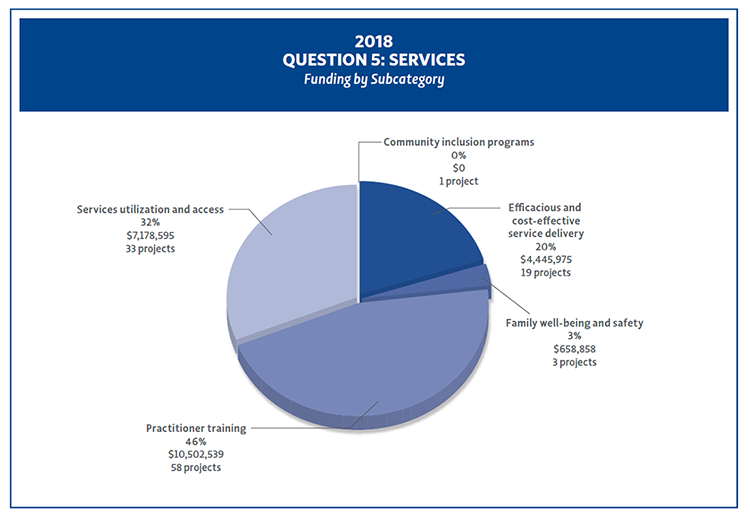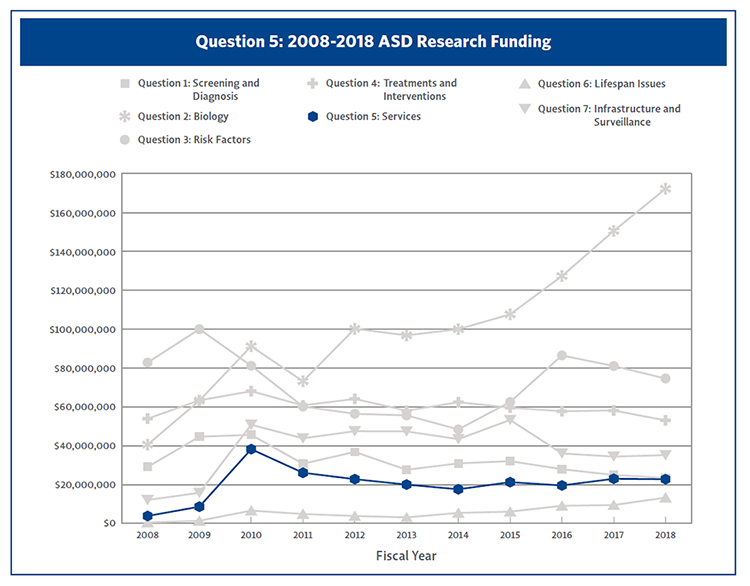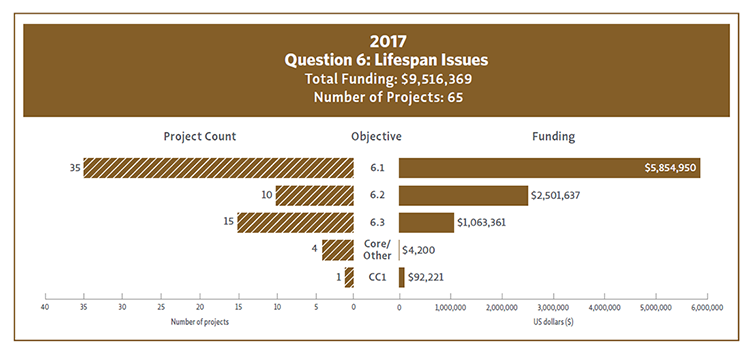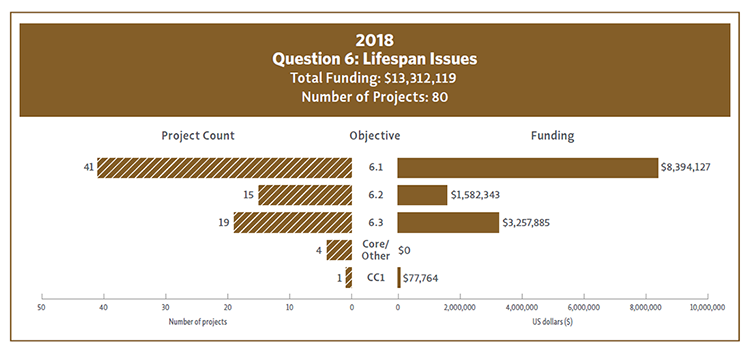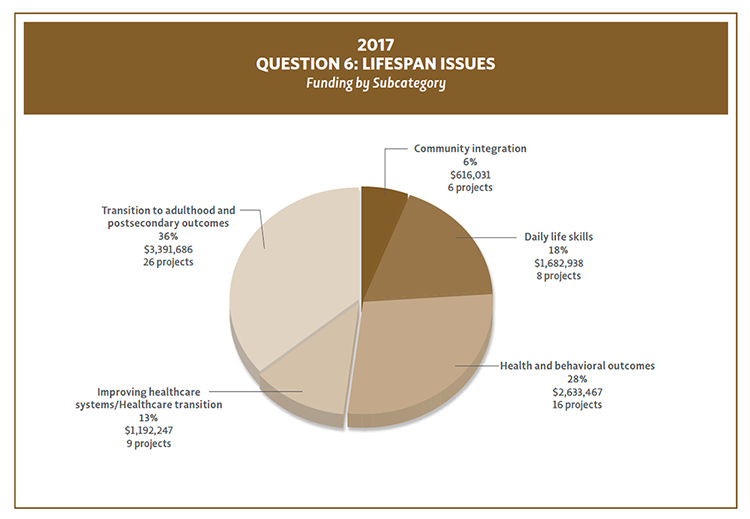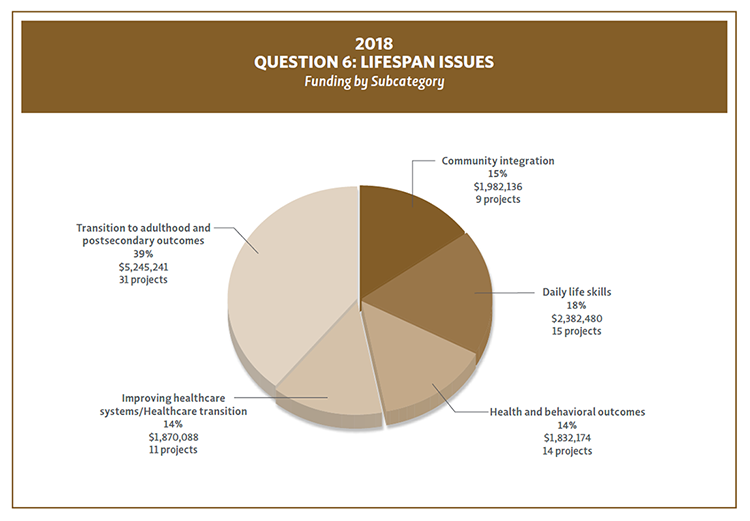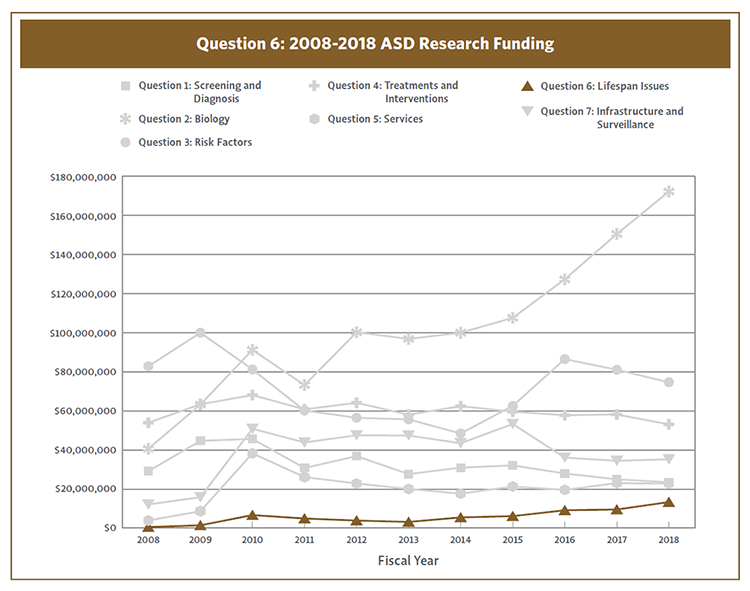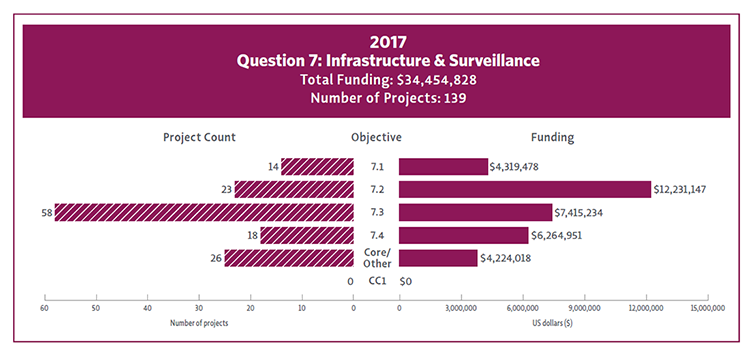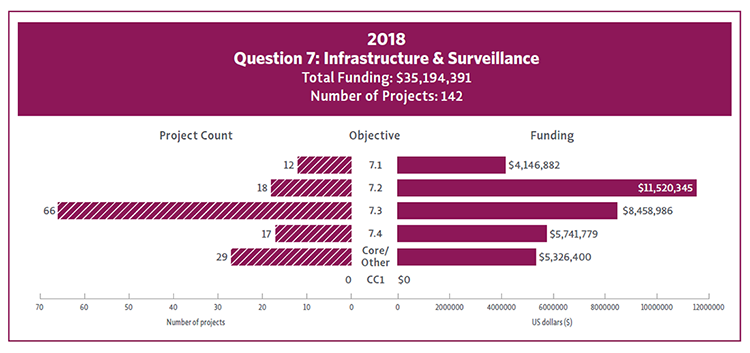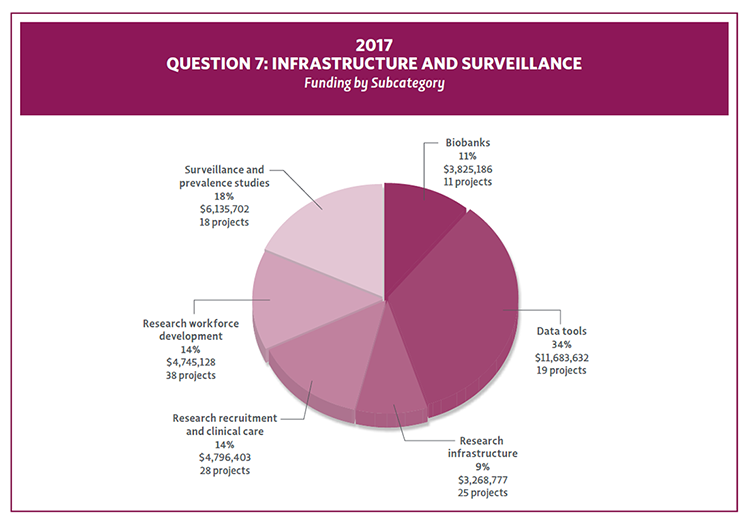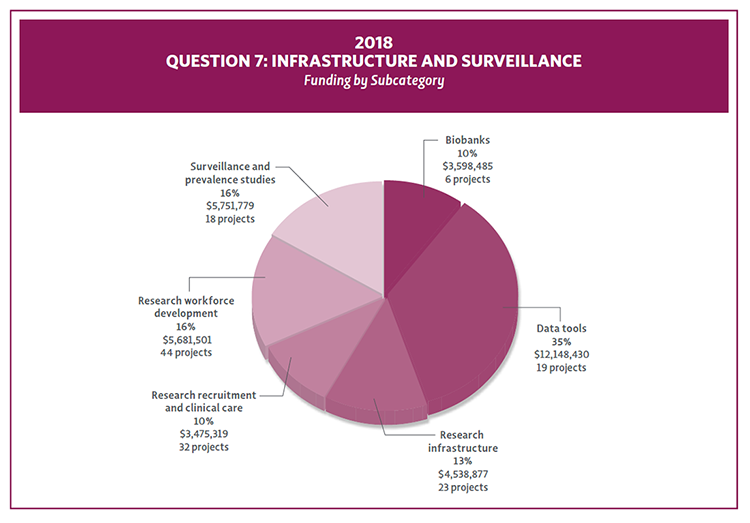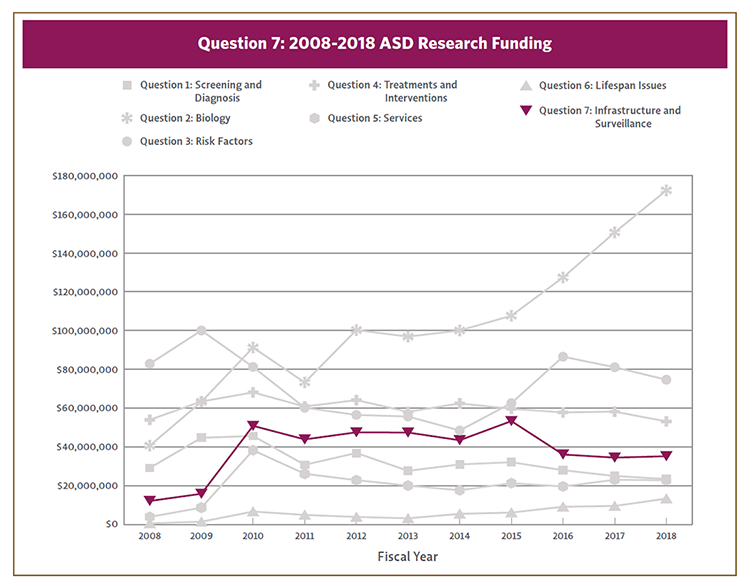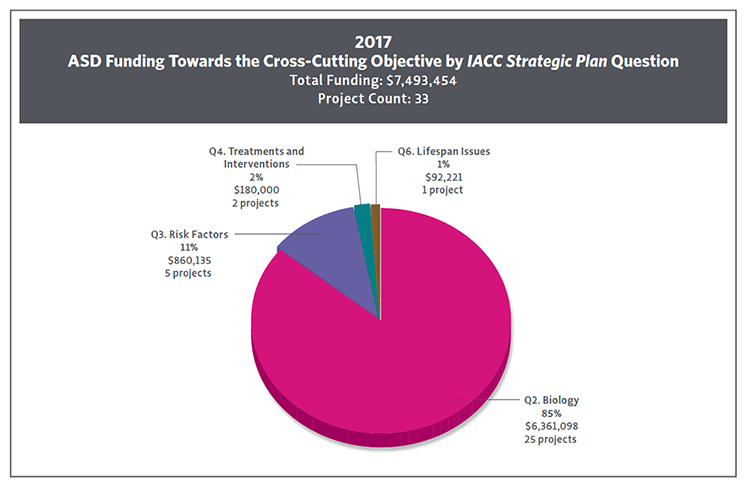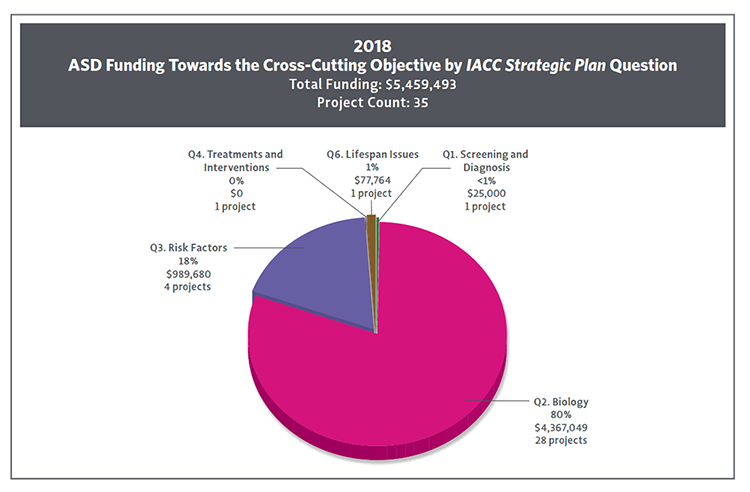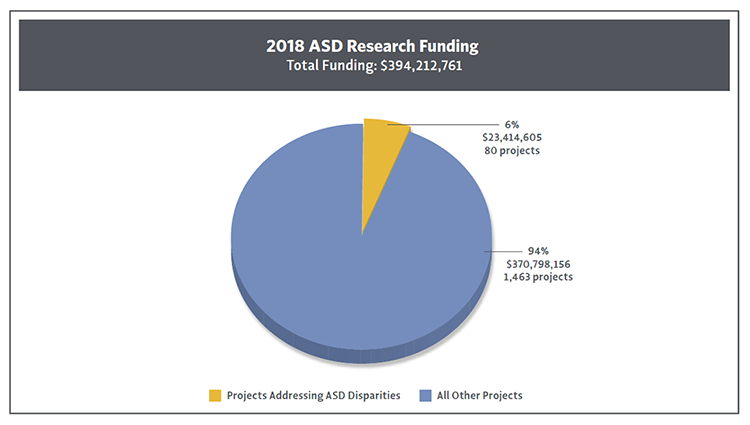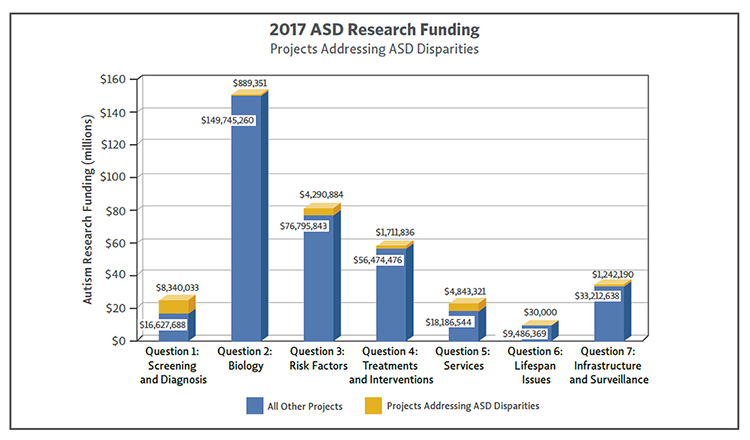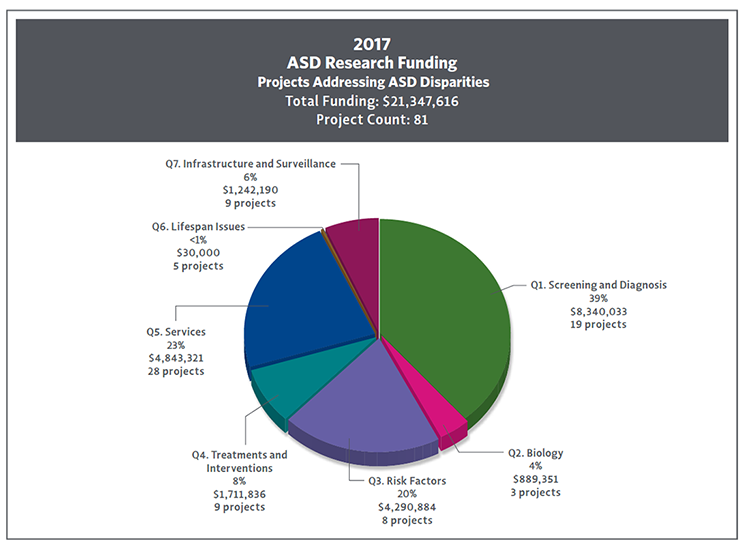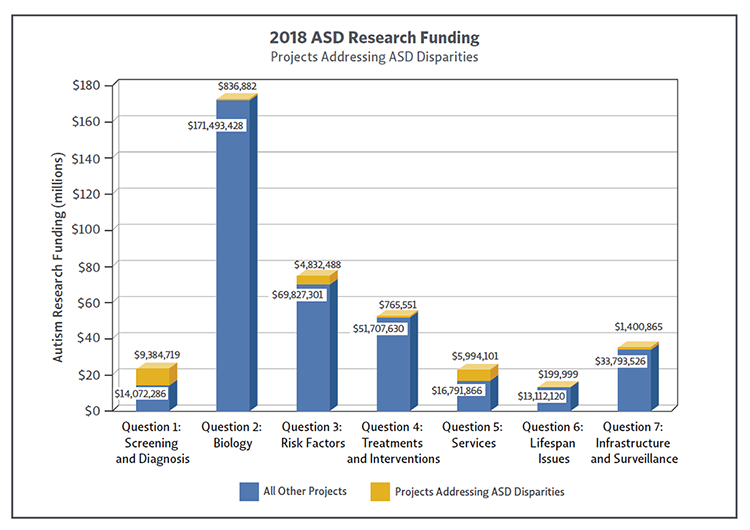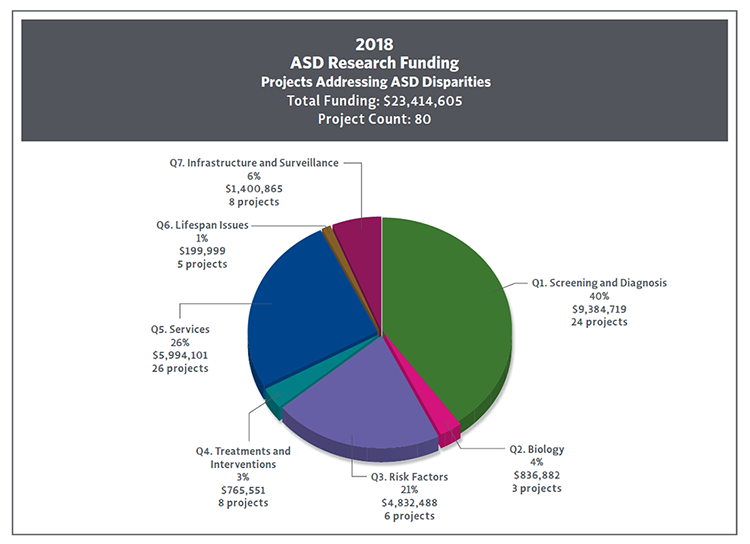Portfolio Analysis Report
IACC Autism Spectrum Disorder Research
2017-2018

ASPIRATIONAL GOAL: Provide the earliest possible diagnosis for people on the autism spectrum, so they can be linked to appropriate interventions, services, and supports in as timely a manner as possible to maximize positive outcomes.
Research Focus of Question 1
Question 1* of the IACC Strategic Plan (“How can I recognize the signs of ASD, and why is early detection so important?”) pertains to the issues surrounding screening for and diagnosis of ASD, with a focus on early identification so that children will have the opportunity to receive interventions and supports that will lead to improved outcomes. The Objectives within this section of the Strategic Plan include research to develop and improve biomarkers, screening tools, and diagnostic instruments to aid in early identification. Question 1 topics also include research to reduce disparities in early detection, including efforts to increase access to health services, and to strengthen the evidence base for the benefits of early detection of ASD. In addition, the Committee prioritized the need for screening and diagnostic tools for use in adolescents and adults; projects addressing issues related to adult screening and diagnosis are captured within Question 6 of the Strategic Plan (focused on issues relevant to transitioning youth and adults on the autism spectrum).
* To visually depict the different types of research funded in 2017 and 2018 in each Question area, word clouds were created using the project titles listed under each Question. These appear at the start of each Question’s section in the report. The size of the word within the word cloud indicates the frequency of its use in the project titles. The word clouds visually portray the main research themes and topics that were associated with the projects categorized under each Question.
Analysis of 2017-2018 Question 1 Portfolio
When analyzing the distribution of research dollars across the seven Question areas described in the IACC Strategic Plan, projects assigned to Question 1 comprised 7% ($25 million) of total ASD research funding in 2017 and 6% ($23.5 million) of funding in 2018. A total of 86 projects were assigned to Question 1 in 2017, which was 6% of all projects. Similarly, 87 projects were aligned to Question 1 in 2018, also representing 6% of total projects. The largest funders of research pertaining to Question 1 in 2017 and 2018 were the National Institutes of Health, Simons Foundation, Department of Education, and the Health Resources and Services Administration. Funding progress made on Question 1 is measured through three primary Objectives and one Cross-Cutting Objective. Figures 20 and 21 provide a detailed overview of each Objective’s total funding in 2017 and 2018 as well as the number of projects assigned to each Objective.
In 2017 and 2018, all three Question 1 primary Objectives received funding. The Question 1 Objective receiving the most funding was 1.3, which aims to improve and develop new tools and service models for detecting ASD; it received 61% ($15.3 million) of the Question 1 funding in 2017 and 54% ($12.7 million) in 2018. Objective 1.3 had most of the Question 1 projects; this corresponds to 64 projects in 2017 and 57 projects in 2018. This was followed by Objective 1.2, which focuses on reducing disparities in early detection and access to services. In 2017, Objective 1.2 accounted for 23% ($5.7 million) of Question 1 funding and included 14 projects. In 2018, Objective 1.2 approximated 24% of Question 1 funding ($5.7 million) and included 15 projects. Objective 1.1 received 16% ($4 million) of Question 1 funding in 2017 and had seven projects; the goal of this Objective is to strengthen the evidence base for the benefits of early detection of ASD. In 2018, Objective 1.1 accounted for 18% ($4.2 million) of Question 1 funding and included 11 projects. The Cross-Cutting Objective (CC1), which focuses on understanding the sex differences in screening and diagnosing ASD under Question 1, did not have any projects in 2017 but had one project in 2018. This one project was focused on understanding the early symptomology differences between boys and girls. Only one project was categorized as Core/Other (i.e., projects not specific to Question 1 Objectives) in 2017; this project studied the integration of new technologies to assess visual and attentional influences on movement and imitative behavior in ASD. Three projects were considered Core/Other in 2018; these included continued funding for the one Core/Other project from 2017, a project investigating the etiologies of “complex” vs. “essential” autism, and a project focused on the neuroethics of predictive MRI testing of parental attitudes towards identification of ASD before the appearance of autistic characteristics.
Figure 20. 2017 funding and project count by Question 1 Objectives. 1.1: Strengthen the evidence base for the benefits of early detection of ASD; 1.2: Reduce disparities in early detection and access to services; 1:3 Improve/validate existing or develop new tools, methods, and service delivery models for detecting ASD in order to facilitate timely linkage of individuals with ASD to early, targeted interventions and supports; Core/Other: Projects that do not align with Question 1 Objectives or support "core" activities in the autism research field; CC1: Support research to understand the underlying biology of sex differences in ASD, possible factors that may be contributing to underdiagnosis, unique challenges that may be faced by girls/women on the autism spectrum, and develop strategies for meeting the needs of this population.
Figure 21. 2018 funding and project count by Question 1 Objectives. See Figure 20 caption above for descriptions of each Objective.
Question 1 Subcategory Analysis
Following the subcategory categorization scheme for the IACC ASD Research Portfolio Analysis, all 2017 and 2018 ASD projects were categorized into broad research-related topic areas or themes, including projects that did not fit within the specific research Objectives laid out in the Strategic Plan. This enables a comprehensive understanding of the distribution of all projects across the general research areas aligning with Question 1. Overall, projects in Question 1 were divided into four subcategories: Diagnostic and screening tools; Early signs and biomarkers; Intermediate phenotypes/Subgroups; and Symptomology (Figures 22 and 23).
Of these four subcategories, the largest proportion of 2017 and 2018 funding was devoted to the development of Diagnostic and screening tools for ASD (59% in 2017; 64% in 2018); this included 42 projects in 2017 and 49 projects in 2018. Identifying Early signs and biomarkers was the second largest research investment in Question 1 (21%, 24 projects in 2017; 24%, 26 projects in 2018). Included in this subcategory were biological indicators (including genetic, metabolic, and brain structure/connectivity) and behavioral biomarkers that can be used for screening/diagnosis or to measure progress or treatment response. In 2017, identifying Intermediate phenotypes/Subgroups people with ASD received 11% of Question 1 funding and accounted for six projects. This was followed by research characterizing Symptomology, which was 9% of Question 1 funding and had 14 projects. In 2018, these last two subcategories both accounted for 6% of Question 1 funding; Intermediate phenotypes/ Subgroups had five projects, and Symptomology included seven projects.
Figure 22. Question 1 funding by subcategory in 2017.
Figure 23. Question 1 funding by subcategory in 2018.
Funding Progress Made on Question 1 From 2008-2018
Figure 24 shows the trend in Question 1 funding over time. When considering annual funding for Question 1 from 2008-2018, portfolio analysis data showed that funding levels stayed relatively flat since 2008, with the exception of 2009 and 2010, during which federal funding for autism research was increased due to the American Recovery and Reinvestment Act.
Figure 24. Question 1 ASD research funding from 2008-2018. Funding for Question 1 was moderate and stayed relatively flat over the eleven-year span.
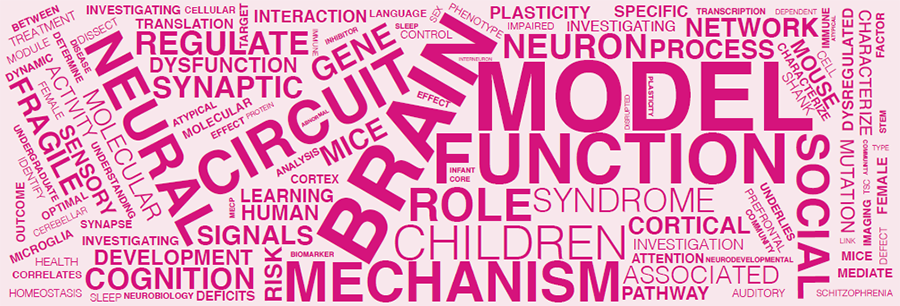
ASPIRATIONAL GOAL: Discover how alterations in brain development and the function of physiological systems lead to ASD in order to enable the development of effective, targeted interventions and societal accommodations that improve quality of life for people on the autism spectrum.
Research Focus of Question 2
Question 2 (“What is the biology underlying ASD?”) seeks to understand the biological differences and mechanisms in early development and throughout life that contribute to ASD features, as well as the characterization of the behavioral and cognitive aspects of ASD. The aim of the research represented by Question 2 is to understand the biological processes underlying ASD from the molecular level to sensory, motor, behavioral, and cognitive development and functioning. Projects range from basic neuroscience using cellular and animal models to clinical studies.
Analysis of 2017-2018 Question 2 Portfolio
Among the seven Question areas described in the IACC Strategic Plan, Question 2 accounted for the largest portion of the ASD research portfolio in 2017 and 2018. Following similar trends as previous years, research on the biology of ASD (Question 2) comprised 39% of total funding ($150.6 million) in 2017 and accounted for 44% ($172.3 million) in 2018. Question 2 also had the largest portion of overall projects in 2017 (38%, 566 projects) and in 2018 (39%, 607 projects). Among federal agencies and private organizations, the National Institutes of Health provided the largest investment, contributing 83% of total Question 2 research funding in 2017 and 88% in 2018. The Simons Foundation was the next largest funder for Question 2 in both years. Research funding under Question 2 is categorized under three primary Objectives and one Cross-Cutting Objective. Figures 25 and 26 provide a detailed overview of each Objective’s total funding in 2017 and 2018 as well as the number of projects assigned to each Objective.
All three primary Objectives in Question 2 and the Cross-Cutting Objective received funding in 2017 and 2018. Objective 2.1 had the most projects, with 73% of Question 2 funding ($109.8 million) in 2017 and 74% ($127.5 million) in 2018. Projects aligned to Objective 2.1 included 451 projects in 2017 and 477 projects in 2018. The aim of this Objective is to better understand the biological, molecular, and brain processes that contribute to ASD. The next largest portion of funding went to Objective 2.3, which focuses on supporting large-scale longitudinal studies that assess the natural lifespan of ASD. In 2017, Objective 2.3 was 12% of Question 2 funding ($17.6 million) and totaled 26 projects, and in 2018, it was 13% of Question 2 funding ($22.6 million) with 33 projects. Objective 2.2, which emphasizes research in understanding co-occurring conditions, received $12 million and accounted for 8% of Question 2 funding in 2017 (42 projects). In 2018, Objective 2.2 had 7% of Question 2 funding ($12.2 million) and included 45 projects. The Cross-Cutting Objective (CC1) received 4% of funding ($6.4 million; 25 projects) in 2017 under Question 2. Similarly, in 2018, 3% of Question 2 funding ($4.4 million; 28 projects) aligned with the Cross-Cutting Objective. The goal for the Cross-Cutting Objective within Question 2 is to understand the biological basis of sex differences in ASD, such as differences in brain structure and functioning among girls and boys. In previous years, Question 2 had a large portion of its funding designated to Core/Other. In 2017 and 2018, only 3% of Question 2 funding was assigned to Core/Other (2017: $4.8 million, 22 projects; 2018: $5.7 million, 24 projects). Projects assigned to Core/Other included research studying the effects of exposure to environmental toxins on the development of the infant gut microbiome and the behavioral effects of fever on young children with autism.
Figure 25. 2017 funding and project count by Question 2 Objectives. 2.1: Foster research to better understand the processes of early development, molecular and neurodevelopmental mechanisms, and brain circuitry that contribute to the structural and functional basis of ASD; 2.2: Support research to understand the underlying biology of co-occurring conditions in ASD and to understand the relationship of these conditions to ASD; 2.3: Support large-scale longitudinal studies that can answer questions about the development of ASD from pregnancy through adulthood and the natural history of ASD across the lifespan; Core/Other: Projects that do not align with Question 2 Objectives or support "core" activities in the autism research field; CC1: Support research to understand the underlying biology of sex differences in ASD, possible factors that may be contributing to under diagnosis, unique challenges that may be faced by girls/women on the autism spectrum, and develop strategies for meeting the needs of this population.
Figure 26. 2018 funding and project count by Question 2 Objectives. See Figure 25 caption above for descriptions of each Objective.
Question 2 Subcategory Analysis
The subcategory analysis is particularly useful for Question 2 in understanding the distribution of research on the underlying mechanisms of ASD. Research in this area covers a broad array of science, and, therefore, Question 2 was divided into several subcategories. These include: Cognitive studies; Computational science; Co-occurring conditions; Developmental trajectory; Immune/Metabolic pathways; Molecular pathways; Neural systems; Neuropathology; Sensory and motor function; and Subgroups/Biosignatures (Figures 27 and 28).
As in previous years, the Question 2 subcategory with the largest portion of funding in 2017 was Molecular pathways (33%, 205 projects), which includes projects seeking to understand systems of genes, proteins, and other molecules that are involved in ASD and related disorders. This trend held for 2018 as well, with Molecular pathways accounting for 34% of Question 2 funding and including 222 projects. Research exploring Neural systems, such as the structure of the brain and functional connections within the brain, was the second largest investment in both 2017 and 2018 (2017: 22%, 104 projects; 2018: 20%, 106 projects). Research into the Developmental trajectory of ASD, including longitudinal studies that follow social, behavioral, and physical development over time, accounted for 13% (29 projects) of Question 2 funding in 2017 and 14% (33 projects) in 2018. The next largest subcategory focused on projects aiming to identify Subgroups/Biosignatures of ASD. In 2017, this subcategory accounted for 8% of Question 2 funding and 55 projects; in 2018, it received 10% of Question 2 funding and included 64 projects. In 2017, research investigating Sensory and motor function, Cognitive studies, and Co-occurring conditions each accounted for 5% of Question 2 funding (50, 34, 27 projects, respectively). Projects examining Immune/ Metabolic pathways received 4% of funding in 2017 (31 projects). Research in the areas of Computational science and Neuropathology each accounted for 3% of Question 2 funding in 2017 (19 and 12 projects, respectively). Comparably, in 2018, Sensory and motor function and Neuropathology each accounted for 5% of Question 2 funding (52 and 22 projects, respectively). Co-occurring conditions accounted for 4% of funding (35 projects). Cognitive studies also received 4% of Question 2 funding and contained 32 projects. This was followed by Immune/Metabolic pathways (2%, 25 projects) and Computational science (2%, 16 projects).
Figure 27. Question 2 funding by subcategory in 2017.
Figure 28. Question 2 funding by subcategory in 2018.
Funding Progress Made on Question 2 From 2008-2018
Figure 29 shows the trend in Question 2 funding over time. Overall, funding for projects within Question 2 was higher than those of other Question areas. When considering annual funding for Question 2 from 2008-2018, funding levels for this Question increased significantly in recent years. It is important to note that the 2016-2017 Strategic Plan Objectives led to the reassignment of some projects from Question 4 to Question 2 Objectives based on the goals of the new Objectives; this may have contributed to the increase. However, Question 2 is the only Question area that has seen a significant increase in funding over the period from 2008-2018. Most of the other research areas remained relatively flat or decreased.
Figure 29. Question 2 ASD research funding from 2008-2018. Funding for Question 2 has experienced several substantial increases in funding over the eleven-year span, leading to a continual upward trend.

ASPIRATIONAL GOAL: Causes of ASD will be discovered that inform diagnosis, prognosis, and interventions and lead to prevention or preemption of the challenges and disabilities of ASD.
Research Focus of Question 3
Question 3 (“What causes ASD, and can disabling aspects of ASD be prevented or preempted?”) focuses on the genetic and environmental factors associated with the development of ASD. Research related to Question 3 explores the role of genetics, epigenetics, and the environment in the development of ASD, as well as the interactions between these types of factors. Question 3 Objectives address topics such as the need to strengthen the understanding of the role of genetics through whole genome sequencing and the relationship with clinical outcomes. Also included are studies to develop improved approaches to investigate environmental exposures and gene-environment interactions.
Analysis of 2017-2018 Question 3 Portfolio
In 2017, research on genetic and environmental factors associated with ASD (Question 3) accounted for $81.1 million (21%) of total ASD research funding. A total of 261 projects were assigned to Question 3, which was 17% of all projects in the 2017 ASD portfolio. In 2018, Question 3 received 19% ($74.7 million) of the portfolio’s funding and included 249 projects (16% of total projects). The largest funders of Question 3 during this period were the National Institutes of Health, Simons Foundation, and the Centers for Disease Control and Prevention. Question 3 consists of three primary Objectives and the Cross-Cutting Objective. Figures 30 and 31 provide a detailed overview of each Objective’s total funding in 2017 and 2018 as well as the number of projects assigned to each Objective.
Each Question 3 Objective received funding in 2017 and 2018. Objective 3.1, which identifies and strengthens the understanding of genetic factors that play a role in the development of ASD, received the largest proportion of funding. In 2017, Objective 3.1 received $42.1 million, which was 52% of Question 3 funding, and included 153 projects. In 2018, Objective 3.1 accounted for 58% of Question 3 funding ($43 million) and contained 153 projects. This was followed by Objective 3.3, which supports projects studying environmental and genetic exposures. Objective 3.3 accounted for 26% of Question 3 funding ($20.7 million) and had 56 projects in 2017. In 2018, Objective 3.3 had 27% of funding (57 projects, $19.9 million). In 2017, Objective 3.2 (focused on environmental factors associated with ASD) received $16.9 million and accounted for 21% of Question 3 funding (45 projects). In 2018, Objective 3.2 totaled $10.7 million in research funding and was 14% of Question 3 funding (35 projects). The Cross-Cutting Objective (CC1) for Question 3, which investigates the genetic and/or environmental factors associated with sex differences in ASD, received $0.9 million (1% of funding, 5 projects) in 2017 and $1 million (1% of funding, 4 projects) in 2018. In 2017, Question 3 Core/Other had two projects that accounted for $0.5 million and 1% of funding; these projects are studying the biological determinants of brain variation in ASD and child social attention and maternal synchrony during early parent-child interactions. 2018 did not include any projects under the Core/Other category.
Figure 30. 2017 funding and project count by Question 3 Objectives. 3.1: Strengthen understanding of genetic factors for ASD across the full diversity and heterogeneity of those with ASD, enabling development of strategies for reducing disability and co-occurring conditions in ASD; 3.2: Understand the effects on ASD of individual and multiple exposures in early development, enabling development of strategies for reducing disability and co-occurring conditions in ASD; 3.3: Expand knowledge about how multiple environmental and genetic factors interact through specific biological mechanisms to manifest in ASD phenotypes; Core/Other: Projects that do not align with Question 3 Objectives or support "core" activities in the autism research field; CC1: Support research to understand the underlying biology of sex differences in ASD, possible factors that may be contributing to under diagnosis, unique challenges that may be faced by girls/women on the autism spectrum, and develop strategies for meeting the needs of this population.
Figure 31. 2018 funding and project count by Question 3 Objectives. See Figure 30 caption above for descriptions of each Objective.
Question 3 Subcategory Analysis
Projects in Question 3 were divided into four subcategories to determine the funding distribution across the research areas relating to understanding and identifying genetic and environmental factors that play a role in the development of ASD. These subcategories include: Environmental risk factors; Epigenetics; Gene-Environment; and Genetic risk factors (Figures 32 and 33).
For both years of the portfolio analysis, studies focused on Genetic risk factors accounted for the highest percentage of Question 3 funding (2017: 52%, 158 projects; 2018: 57%, 152 projects). The next largest Question 3 subcategory investigates the role of environmental factors, genetic susceptibility, and/or the context of human physiology (Gene-Environment); this subcategory received 24% of Question 3 funding and included 45 projects in 2017 and received 22% of funding and included 40 projects in 2018. Projects considering only Environmental risk factors received 19% of Question 3 funding in 2017 (40 projects). In 2018, this subcategory accounted for 14% of Question 3 funding and had 32 projects. Projects on Epigenetics received 5% of funding (18 projects) in 2017 and 7% of funding (25 projects) in 2018; these included studies investigating DNA modifications and exploring altered gene expression due to environmental influences.
Figure 32. Question 3 funding by subcategory in 2017.
Figure 33. Question 3 funding by subcategory in 2018.
Funding Progress Made on Question 3 From 2008-2018
Figure 34 shows the trend in Question 3 funding over time. While research on risk factors remained funded at high levels over the eleven-year period compared to some of the other Question areas, Question 3 has experienced several fluctuations in funding throughout the years. The overall trend showed an initial increase in funding followed by a sharp decrease and then smaller decreases in funding from 2011-2014. From 2014-2016 there was a significant increase. The increase in 2016, due in part to reassignment of SPARK genetics projects to a new Objective within Question 3, has brought Question 3 funding in 2016 to levels comparable with 2008 funding, though funding levels have decreased slightly in both 2017 and 2018.
Figure 34. Question 3 ASD research funding from 2008-2018. Over the eleven-year span, funding for Question 3 initially showed an increase followed by a sharp decrease, then a gradual decrease, a rapid increase from 2014-2016, and finally a slight decrease between 2016 and 2018.

ASPIRATIONAL GOAL: Develop a range of targeted treatments and interventions that optimize function and abilities across the lifespan to achieve meaningful outcomes and maximize quality of life for people on the autism spectrum.
Research Focus of Question 4
Question 4 asks “Which treatments and interventions will help?” and covers a range of intervention approaches currently being considered, including pharmacological, behavioral, occupational, and technology-based approaches. Research in this field encompasses the development of new treatments using genetically-targeted pharmacology and combination therapies. Question 4 also includes research to ensure interventions include the whole autism spectrum and diverse populations.
Analysis of 2017-2018 Question 4 Portfolio
Research focused on interventions and treatments received $58.2 million (15%) of total ASD funding in 2017. The number of projects assigned to Question 4 totaled 273 projects, which was 18% of all projects included in the portfolio. In 2018, funding towards Question 4 accounted for 13% of the portfolio ($52.5 million) and 17% of total projects (264 projects). Many agencies and organizations invest in treatments and interventions; however, the funders with the largest contributions during this period were the National Institutes of Health, the Department of Defense - Army, the Health Resources and Services Administration, and the Department of Education. Question 4 has three primary Objectives and the Cross-Cutting Objective. Figures 35 and 36 provide a detailed overview of each Objective’s total funding and the number of projects assigned to each Objective in 2017 and 2018.
Every Objective in Question 4 as well as the Cross-Cutting Objective had assigned projects or funding for both years of the portfolio analysis; however, there were differences in funding levels among the Objectives for 2017 and 2018. The Question 4 Objective receiving the most funding in 2017, Objective 4.2, focuses on the development of psychosocial and naturalistic interventions ($26.4 million, 45%); this Objective also had the largest number of projects in 2017 (124 projects). Objective 4.2 was the second largest funded Objective in 2018; it accounted for 34% of Question 4 funding ($17.9 million) and included 120 projects. Objective 4.1 received 42% of 2017’s Question 4 funding with $24.2 million and 84 projects; this Objective includes research on pharmacological and medical interventions. Objective 4.1 received the most funding in 2018, accounting for 49% of Question 4’s funding ($25.9 million) and 85 projects. The increase in funding for Objective 4.1 in 2018 included large grants for the National Institutes of Health's Autism Biomarkers Consortium for Clinical Trials and the Health Resources and Services Administration's Autism Intervention Research Network on Physical Health (AIR-P network). Objective 4.3 received the lowest levels of funding each year, with the goal to optimize development of technology-based interventions; it received $5.7 million (10%) and had 53 projects in 2017 and $7.3 million (14%) and had 50 projects in 2018. The aim of the Cross-Cutting Objective (CC1) within Question 4 is to investigate treatment/ intervention response based on sex differences and explore the development of interventions that address sex differences. In 2017, funding for projects associated with the Cross-Cutting Objective totaled $180,000 (<1%, 2 projects); in 2018, one of these projects was considered ongoing but did not receive any further funding. The rest of Question 4 funding went to projects categorized as Core/Other, which accounted for $1.6 million (3%) and 10 projects in 2017 and $1.5 million (3%) and eight projects in 2018. Projects assigned to Core/Other included parent training interventions and assessing brain imaging markers in response to interventions in toddlers with autism.
Figure 35. 2017 funding and project count by Question 4 Objectives. 4.1: Foster research to better understand the processes of early development, molecular and neurodevelopmental mechanisms, and brain circuitry that contribute to the structural and functional basis of ASD; 4.2: Support research to understand the underlying biology of co-occurring conditions in ASD and to understand the relationship of these conditions to ASD; 4.3: Support large-scale longitudinal studies that can answer questions about the development of ASD from pregnancy through adulthood and the natural history of ASD across the lifespan; Core/Other: Projects that do not align with Question 4 Objectives or support "core" activities in the autism research field; CC1: Support research to understand the underlying biology of sex differences in ASD, possible factors that may be contributing to under diagnosis, unique challenges that may be faced by girls/women on the autism spectrum, and develop strategies for meeting the needs of this population.
Figure 36. 2018 funding and project count by Question 4 Objectives. See Figure 35 caption above for descriptions of each Objective.
Question 4 Subcategory Analysis
Question 4 represents research on a wide array of treatments and interventions for ASD, ranging from medications to alleviate core and co-occurring conditions, to behavioral therapies and technologies to improve communication, social skills, life skills, and learning. Projects under Question 4 were broken down into these seven subcategories: Behavioral; Complementary, dietary, and alternative; Educational; Medical/Pharmacologic; Model systems/Therapeutic targets; Occupational, physical, and sensory-based; and Technology-based interventions and supports (Figures 37 and 38).
The subcategories for Question 4 illustrate the many approaches to treatments and interventions supported by autism research funders. In 2017 and 2018, the largest amount of funding supported projects to develop Behavioral interventions (2017: 35%, 102 projects; 2018: 24%, 87 projects), including applied behavior analysis (ABA), cognitive therapy, and social skills training. In 2017, research on Model systems/Therapeutic targets (23%, 33 projects) followed, focusing on early development of animal and cellular models that mimic characteristics of ASD to test experimental therapies. This subcategory was the third highest funded area in 2018 (22%, 32 projects).
As described in the 2016 IACC Portfolio Analysis Report, Objectives experienced a shift in the categorization of some projects using ASD model systems due to the new Objectives introduced in the 2016-2017 Strategic Plan. Model systems projects were formerly all assigned to Question 4; however, under the 2016-2017 Strategic Plan, some of these projects are now better aligned with Question 2, while those specifically focused on testing new drugs and treatments remain in Question 4. The next largest subcategory in 2017 was Medical/Pharmacologic interventions, which received 18% of funding (46 projects). In 2018, this subcategory was the second largest funded research area, with 22% of Question 4 funding and 48 projects. As mentioned in the previous section, there were several large grants funded in 2018 focused on improving pharmacological and medical interventions and treatments. Technology-based interventions and supports received 9% of funding (50 projects) in 2017 and 14% of funding in 2018 (51 projects). For both years, Educational (classroom-based) interventions received 8% of funding (17 projects in 2017, 21 projects in 2018). The subcategories with the smallest amounts of funding included Occupational, physical, and sensory-based (2017: 5%, 17 projects; 2018: 7%, 16 projects) and Complementary, dietary, and alternative interventions (2017: 2%, 8 projects; 2018: 3%, 9 projects).
Figure 37. Question 4 funding by subcategory in 2017.
Figure 38. Question 4 funding by subcategory in 2018.
Funding Progress Made on Question 4 From 2008-2018
The trend in annual Question 4 funding over time is shown in Figure 39. Overall, research funding focused on treatments and interventions maintained a steadily moderate level over the eleven-year time span. Question 4 has consistently had one of the largest proportions of funding compared to other Question areas.
Figure 39. Question 4 ASD research funding from 2008-2018. Funding for Question 4 remained primarily flat, but relatively robust, over the eleven-year span.

ASPIRATIONAL GOAL: Communities will develop, access, and implement high-quality, evidence-based services and supports that maximize quality of life and health across the lifespan for all people with ASD and their families.
Research Focus of Question 5
Question 5 (“What kinds of services and supports are needed to maximize quality of life for people on the autism spectrum?”) focuses on funding research on services and supports for people with ASD. Objectives address issues to improve the efficacy, cost-effectiveness, and dissemination of evidence-based practices in community settings, to support research to understand and develop strategies to address health disparities, and to develop better tools to measure ASD service models at the federal, state, and local levels. Question 5 also includes support for research to develop and evaluate the training of service providers who work with individuals with ASD, particularly identifying culturally appropriate best practices.
Analysis of 2017-2018 Question 5 Portfolio
Projects assigned to Question 5 comprised 6% of the total ASD research supported in 2017 ($23 million) and consisted of 118 projects, which was 8% of the total number of ASD projects. Similarly, Question 5 accounted for 6% of 2018’s research portfolio ($22.8 million) and included 114 projects (7%). The largest funders of Question 5 were the National Institutes of Health, Department of Education, and Centers for Disease Control and Prevention. Question 5 consists of three primary Objectives and the Cross-Cutting Objective. Figures 40 and 41 provide a detailed overview of each Objective’s total funding in 2017 and 2018 as well as the number of projects assigned to each Objective.
All three primary Objectives in Question 5 received funding in 2017 and 2018. The majority of projects that were categorized under this Question went towards Objective 5.3, which supports developing and improving service models to improve the quality of care individuals receive from ASD services. Objective 5.3 was 62% of the 2017 Question 5 portfolio, receiving $14.3 million in funding and included 76 projects. In 2018, Objective 5.3 accounted for 61% of Question 5’s funding ($14 million) and included 78 projects. The next largest portion of funding went to Objective 5.1, which addresses the gaps between research and practice when implementing evidence-based practices within the community. This Objective received $8.1 million (35%) in 2017 and had 30 projects; in 2018, this Objective totaled $7.7 million (34%) and had 25 projects. Objective 5.2, research focused on reducing the disparities in access to services for underserved populations, followed with $0.2 million and 1% of Question 5 funding for both 2017 and 2018 (7 projects in 2017, 9 projects in 2018). In 2017, Question 5 Core/Other received 2% of Question 5 funding, with nearly $400,000 and five projects. In 2018, Question 5 Core/Other included 4% of total Question 5 funding ($875,000) and two projects. Projects assigned to Core/Other included developing and testing an incident alert system to be used with law enforcement officials and caregivers as well as training for professionals in specialized education. The Cross-Cutting Objective (CC1) which focuses on sex differences in ASD did not receive any Question 5 funding in 2017 or 2018. Future projects that would potentially fit in the Cross-Cutting Objective within Question 5 include studies of differences in services and supports needs based on sex and gender.
Figure 40. 2017 funding and project count by Question 5. Objectives 5.1: Scale up and implement evidence-based interventions in community settings; 5.2: Reduce disparities in access and in outcomes for underserved populations. 5.3: Improve service models to ensure consistency of care across many domains with the goal of maximizing outcomes and improving the value that individuals get from services; Core/Other: Projects that do not align with Question 5 Objectives or support "core" activities in the autism research field; CC1: Support research to understand the underlying biology of sex differences in ASD, possible factors that may be contributing to under diagnosis, unique challenges that may be faced by girls/women on the autism spectrum, and develop strategies for meeting the needs of this population.
Figure 41. 2018 funding and project count by Question 5 Objectives. See Figure 40 caption above for descriptions of each Objective.
Question 5 Subcategory Analysis
Projects within Question 5 have been categorized into five subcategories which reflect the general scope of research on services and supports: Community inclusion programs; Efficacious and cost-effective service delivery; Family well-being and safety; development and evaluation of Practitioner training; and Services utilization and access (Figures 42 and 43).
In 2017 and 2018, research concerning the development and evaluation of Practitioner training, largely represented in the Health Resources and Services Administration’s Leadership Education in Neurodevelopmental and Related Disabilities (LEND) programs, accounted for the majority of Question 5 funding (2017: 44%, 58 projects; 2018: 46%, 58 projects). Projects related to research on Efficacious and cost-effective service delivery, which covers research projects that assess current service delivery models as well as developing new and efficient ways of providing services, aligned with 26% of Question 5 funding (17 projects) in 2017 and 20% of funding in 2018 (19 projects). Research focused on disparities and potential barriers to access are covered in Services utilization and access and accounted for 25% of Question 5 funding in 2017 (35 projects) and 32% in 2018 (33 projects). Funding for this subcategory saw a significant increase in funding from 2016, when it was only 2% of Question 5 funding and seven projects. This research area saw several large projects funded in 2017 and 2018 by the National Institutes of Health focused on implementing evidence-based interventions in real-world settings. Family well-being and safety research projects followed with 5% of 2017 funding (7 projects) and 3% of 2018 Question 5 funding (3 projects). One project was categorized as Community inclusion programs and received less than 1% of 2017 funding and received no funding in 2018 (the project funded in 2017 received all of its funding in 2017 and the work continued into 2018 without additional funding).
Figure 42. Question 5 funding by subcategory in 2017.
Figure 43. Question 5 funding by subcategory in 2018.
Funding Progress Made on Question 5 From 2008-2018
Figure 44 shows the trend in Question 5 funding over time. Research related to Question 5 was funded at relatively low levels when compared to other Question areas. Funding for projects within Question 5 appeared to decrease after 2010.* Overall, when comparing 2008 funding for Question 5 with 2018 funding, the general trend is upward. In recent years, funding has stayed consistent.
Figure 44. Question 5 ASD research funding from 2008-2018. Compared to other Strategic Plan Questions, funding for Question 5 remained relatively low over the eleven-year span.
* As explained in prior Portfolio Analysis Reports, adjustments in reporting were made to the 2010 portfolio to only report autism-specific and research-related portions of large, broad disability projects that are included in Question 5. The figure displays the Question 5 funding in 2010 using the criteria that were applied in later years to enable a more accurate comparison among all the years of analysis. The projects that included practitioner training were prorated starting in 2011 to include only the portion of funding pertaining to development and evaluation of training, and not portions related to delivery of training.

ASPIRATIONAL GOAL: All people with ASD will have the opportunity to lead self determined lives in the community of their choice through school, work, community participation, satisfying relationships, and meaningful access to services and supports.
Research Focus of Question 6
With increasing societal awareness of the needs of people on the autism spectrum across the lifespan, Question 6 addresses the question “How can we meet the needs of people with ASD as they progress into and through adulthood?”. Question 6 encompasses research to identify and address issues surrounding transitioning to adulthood, improving co-occurring physical and mental health conditions for adults, and incorporating acceptance and independence of people with ASD in services and outreach efforts. Some of the research in Question 6 represents projects that assess outcome measures such as quality of life, health, independence, and employment for people on the autism spectrum, particularly with respect to interventions and services they might have received. Many projects assigned to Question 6 focus on adolescents transitioning from the secondary education system to higher education and/or employment, as well as vocational/job skills and social skills training for both transition-aged youth and adults.
Analysis of 2017-2018 Question 6 Portfolio
In 2017, research on lifespan issues associated with ASD (Question 6) accounted for 2% ($9.5 million) of total ASD research funding and included 65 projects (4% of total projects). In 2018, Question 6 totaled 3% of the portfolio’s funding ($13.3 million) and contained 80 projects (5% of all projects). This Question area had the smallest portion of funding and number of projects for each year of the portfolio analysis. The agencies and organizations with the largest stakes in this research in 2017 were the National Institutes of Health, the New Jersey Governor’s Council for Medical Research and Treatment of Autism (which is included for the first time in the IACC Portfolio Analysis Report), and the National Science Foundation. In 2018, the top three funders of Question 6 research were the National Institutes of Health, Department of Defense – Army, and the Administration for Community Living. As mentioned in an earlier section of this report, Question 6 saw the largest proportion of funding for new projects; furthermore, the interest of diverse funders in this topic demonstrates the community’s growing commitment to support research in this area. Question 6 has three primary Objectives and the Cross-Cutting Objective. Figures 45 and 46 provide a detailed overview of each Objective’s total funding as well as the number of projects assigned to each Objective.
For both 2017 and 2018, all three primary Objectives and the Cross-Cutting Objective assigned to Question 6 received funding. The largest portion of funding went to research supporting the transition to adulthood; Objective 6.1 accounted for 62% of Question 6 funding in 2017, which totaled $5.9 million and 35 projects. In 2018, Objective 6.1 was 63% of Question 6 funding ($8.4 million) and supported 41 projects. In 2017, Objective 6.2 received $2.5 million (26%) and included 10 projects; the goal of this Objective is to conduct research to enhance quality of life and reduce the disabling effects of co-occurring conditions. In 2018, Objective 6.2 received $1.6 million (12%) and contained 15 projects. Research focused on community integration, Objective 6.3, accounted for 11% of the 2017 Question 6 funding with $1.1 million and 15 projects. In 2018, this Objective was 24% of Question 6 funding ($3.3 million) and included 19 projects. In 2017 and 2018, four projects in Question 6 were categorized as Core/Other. Projects assigned to Core/Other included studies of the cognitive and neural effects of aging in autism as well as an epidemiological study assessing adult outcomes. The Cross-Cutting Objective (CC1), which supports research to understand the sex differences of ASD, received 1% of the funding (1 project) in 2017 and 2018.
Figure 45. 2017 funding and project count by Question 6 Objectives. 6.1: Support development and coordination of integrated services to help youth make a successful transition to adulthood and provide supports throughout the lifespan; 6.2: Support research and implement approaches to reduce disabling co-occurring physical and mental health conditions in adults with ASD, with the goal of improving safety, reducing premature mortality, and enhancing quality of life; 6.3: Support research, services activities, and outreach efforts that facilitate and incorporate acceptance, accommodation, inclusion, independence, and integration of people on the autism spectrum into society; Core/Other: Projects that do not align with Question 6 Objectives or support "core" activities in the autism research field; CC1: Support research to understand the underlying biology of sex differences in ASD, possible factors that may be contributing to under diagnosis, unique challenges that may be faced by girls/women on the autism spectrum, and develop strategies for meeting the needs of this population.
Figure 46. 2018 funding and project count by Question 6 Objectives. See Figure 45 caption above for descriptions of each Objective.
Question 6 Subcategory Analysis
From 2010-2016, the number of projects aligned with Question 6 were relatively low, limiting the opportunity to create subcategories within Question 6. Additionally, many projects in the Question 6 research area encompassed more than one topic, making it difficult to group these research projects into subcategories. However, in 2017 and 2018, there was a substantial increase in the number of projects aligned with Question 6, allowing projects for these years to be assessed for subcategory development. Based on the projects in the portfolio, in addition to priority areas discussed at IACC meetings, the OARC staff created five Question 6 subcategories that will be used to track trends in subtopics of research on ASD across the lifespan: Transition to adulthood and post-secondary outcomes, Community integration supports and services, Health and behavioral outcomes, Improving healthcare systems/Healthcare transitions, and Daily life skills (Figures 47 and 48). As mentioned previously, Question 6 projects typically address several subtopics within one project, sometimes making it difficult to assign to one subcategory. For the purposes of the IACC Portfolio Analysis Report, projects were only coded to one subcategory, aligning the project with its main research goal. Detailed descriptions of the new Question 6 subcategories are included in Appendix B.
In 2017 and 2018, the largest funded subcategory was Transition to adulthood and post-secondary outcomes, which focuses on improving services and interventions during this transition period as well as understanding life outcomes after high school, such as employment and college. In 2017, this subcategory received 36% of Question 6 funding and included 26 projects. In 2018, this subcategory received 39% of funding and totaled 31 projects. Health and behavioral outcomes focus on understanding the health-related outcomes for youth and adults, including interventions for co-occurring conditions and core disabilities; this subcategory accounted for 28% of Question 6 funding in 2017 (16 projects) and 14% of funding in 2018 (14 projects). Daily life skills include projects that teach independent living skills, such as self-determination and goal setting, to youth and adults. In 2017 and 2018, Daily life skills accounted for 18% of Question 6 funding (8 projects in 2017 and 15 projects in 2018). Improving healthcare systems/Healthcare transitions includes projects focused on improving provider-patient experiences and the development of specific screening and diagnostic tools for ASD in adults and co-occurring conditions related to ASD. In 2017, this subcategory had 13% of Question 6 funding and included nine projects; in 2018, it aligned with 14% of funding and had 11 projects. Projects developing Community integration supports and services aim to increase inclusion of autistic adults in community settings while also developing interventions and supports that improve community involvement among youth and adults with ASD. This subcategory received 6% of funding in 2017 (6 projects) and 15% of funding in 2018 (9 projects).
Figure 47. Question 6 funding by subcategory in 2017.
Figure 48. Question 6 funding by subcategory in 2018.
Funding Progress Made on Question 6 From 2008-2018
Research related to Question 6 has received the lowest level of annual funding for every year of the eleven-year analysis period (Figure 49). Although there was a small increase in funding for this Question area from 2009-2010 and 2014-2018, the overall trend shows that funding for this Question has stayed low and relatively flat. However, Question 6 experienced its highest amount of funding in 2018. In the 2016-2017 IACC Strategic Plan, the IACC recommended a doubling of ASD research funding, including increased funding for research on adults, to better understand autism in adulthood, and to develop tools, strategies, and best practices for addressing the needs of autistic adults. This area will continue to be monitored for progress toward that recommendation in the future.
Figure 49. Question 6 ASD research funding from 2008-2018. Funding for Question 6 remained low over the eleven-year span but recently experienced a slight increase.

ASPIRATIONAL GOAL: Develop, enhance, and support infrastructure and surveillance systems that advance the speed, efficacy, and dissemination of ASD research and services.
Research Focus of Question 7
Question 7 (“How do we continue to build, expand, and enhance the infrastructure system to meet the needs of the ASD community?”) covers the topics of research infrastructure, data sharing, ASD surveillance, and communication/dissemination of research findings and evidence-based practices. There is also a focus on increasing participation in the collection of biospecimens as well as developing the professional workforce that conducts research and provides services to individuals with autism and their families.
Analysis of 2017-2018 Question 7 Portfolio
Projects assigned to Question 7 comprised 9% ($34.5 million) of the total ASD research supported in 2017 and consisted of 139 projects, which was 9% of the total number of projects. In 2018, Question 7 accounted for 9% of the total research funding ($35.2 million) and 9% of total projects (142 projects). In 2017 and 2018, the National Institutes of Health, Simons Foundation, and the Centers for Disease Control and Prevention were the largest funders of Question 7 research. Question 7 consists of four primary Objectives and the Cross-Cutting Objective. Figures 50 and 51 provide a detailed overview of each Objective’s total funding as well as the number of projects assigned to each Objective.
Question 7’s primary four Objectives received funding in 2017 and 2018. In 2017, the largest portion of funding went towards Objective 7.2, , which focuses on developing and enhancing data banks and data sharing ($12.2 million, 35% of funding). Objective 7.2 had 23 projects; this is not the largest share of projects in Question 7, as projects focused on data infrastructure often require more funding per project. In 2018, Objective 7.2 accounted for 33% of Question 7 funding ($11.5 million) and had 18 projects. Funding towards programs enhancing the research workforce and developing interdisciplinary training (Objective 7.3) received the second largest amount of funding ($7.4 million, 22%) in 2017 and had greatest portion of projects (58 projects). Objective 7.3 also had the largest number of projects (66 projects) in 2018, with $8.5 million (24%) in funding. Objective 7.4 followed with $6.3 million (18%) in 2017 and 18 projects; this Objective supports the expansion of ASD surveillance systems. In 2018, this Objective accounted for $5.7 million (16%) and had 17 projects. Objective 7.1, which supports increasing biospecimen donations and encouraging integration of biorepository banks, was 13% of Question 7 funding ($4.3 million) in 2017 and had 14 projects; in 2018, Objective 7.1 accounted for $4.1 million (12%) and had 12 projects. In 2017, there were 26 projects, accounting for $4.2 million, that did not fit into a specific Question 7 Objective and were assigned to Core/Other. Comparably, there were 29 projects with $5.3 million in funding towards Core/Other in 2018. Projects assigned to Core/Other include data and administrative centers for large, multisite research projects and a project supporting the development of a research agenda for online STEM K-12 education. The Cross-Cutting Objective (CC1) did not receive any funding under Question 7 in 2017 or 2018. Research within the Cross-Cutting Objective that would be relevant to Question 7 would include infrastructure, surveillance, researcher training, or dissemination of findings related to research on sex differences in ASD.
Figure 50. 2017 funding and project count by Question 7 Objectives. 7.1: Promote growth, integration, and coordination of biorepository infrastructure; 7.2: Develop, enhance, and link data repositories; 7.3: Expand and enhance the research and services workforce, and accelerate the pipeline from research to practice; 7.4: Strengthen ASD surveillance systems to further understanding of the population of individuals with ASD, while allowing comparisons and linkages across systems as much as possible; Core/Other: Projects that do not align with Question 7 Objectives or support "core" activities in the autism research field; CC1: Support research to understand the underlying biology of sex differences in ASD, possible factors that may be contributing to under diagnosis, unique challenges that may be faced by girls/women on the autism spectrum, and develop strategies for meeting the needs of this population.
Figure 51. 2018 funding and project count by Question 7 Objectives. See Figure 50 caption above for descriptions of each Objective.
Question 7 Subcategory Analysis
The six subcategories in Question 7 reflect the broad array of ASD research infrastructure needs that have been identified by the IACC: Biobanks; Data tools; Research infrastructure; Research recruitment and clinical care; Research workforce development; and Surveillance and prevalence studies (Figures 52 and 53).
In Question 7, the subcategories encompass a diverse set of project types, with funding distributed relatively evenly across them. In 2017 and 2018, Data tools, such as the National Database for Autism Research (NDAR) and the Autism Genetics Resource Exchange (AGRE), received the largest portion of funding (2017: 34%, 19 projects; 2018: 35%, 19 projects). Surveillance and prevalence studies, such as studies under the ADDM Network, had 18% of Question 7 funding (18 projects) in 2017 and 16% of funding (18 projects) in 2018. Research workforce development, which supports conferences and training for autism researchers, accounted for 14% of funding in 2017 (38 projects) and 16% in 2018 (44 projects). Research recruitment and clinical care, which helps increase participation in research studies and conduct medical evaluations of participants, received 14% of funding (28 projects) in 2017; this subcategory received 10% of Question 7 funding in 2018 (32 projects). Biobanks received 11% of Question 7 funding in 2017 (11 projects) and 10% of funding in 2018 (6 projects). Funding supporting coordinating centers that analyze data and disseminate research to the community are included within Research infrastructure, which received 9% of Question 7 funding in 2017 (25 projects) and 13% of 2018 funding (23 projects). The increase in 2018 funding for Research infrastructure included the addition of two new large projects; the first funded by the New Jersey Governor’s Council for Medical Research and Treatment of Autism to establish the New Jersey Autism Center of Excellence and the second funded by the National Institutes of Health to support the Duke Center for Autism and Brain Development.
Figure 52. Question 7 funding by subcategory in 2017.
Figure 53. Question 7 funding by subcategory in 2018.
Funding Progress Made on Question 7 From 2008-2018
Figure 54 shows the trend in Question 7 funding over the eleven-year span of 2008-2018. Research within Question 7 experienced a rapid increase in funding from 2008-2010. After 2010, funding levels for infrastructure and surveillance projects leveled off to a flat, moderate level from 2010-2014. The year 2015 saw a slight increase in funding for Question 7 research projects; however, it was followed by a significant decrease in 2016. Funding levels have since remained relatively stable in 2017 and 2018.
Figure 54. Question 7 ASD research funding from 2008-2018. Following an initial increase from 2008-2010, funding for Question 7 remained relatively flat from 2010-2018.
Cross-Cutting Objective: Sex Differences in ASD
In addition to the 22 primary Objectives, the 2016-2017 IACC Strategic Plan includes one Cross-Cutting Objective (CC1) on the topic of ASD in females: “Support research to understand the underlying biology of sex differences in ASD, possible factors that may be contributing to underdiagnosis, unique challenges that may be faced by girls/women on the autism spectrum, and develop strategies for meeting the needs of this population.” This “Cross-Cutting” Objective was developed to combine the priorities on research and services to understand and better serve the needs of girls and women on the autism spectrum. Individual projects assigned to this Objective are coded to different Questions of the Strategic Plan depending on which aspect of ASD in girls and women is being studied. This ensures that the funding associated with those projects will be counted toward the totals of their respective Questions and also allows the projects to be added together into a single Objective. The goal of a single "Cross-Cutting" Objective on girls and women with ASD is to encompass the numerous research and services priorities identified by the Committee throughout the Strategic Plan and allow for this area to be identified as a priority for funders. Examples of projects that are included in the Cross-Cutting Objective are those that focus on the underlying biology of ASD in girls/women (differences in brain structure, function, physiology), development of strategies to meet the intervention, service, and support needs of girls/women with ASD, identifying factors that contribute to sex differences, and projects that develop, adapt, or validate screening and diagnostic tools to detect ASD in girls and women.
The Question-specific sections above provide an illustration of projects and funding devoted to the Cross-Cutting Objective within each Question area of the Strategic Plan. In this section, we provide additional analysis of the Cross-Cutting Objective across all Questions to provide a complete depiction of the number of projects and funding that were dedicated to the topic of ASD in girls/women. In 2017, the amount of funding devoted to the Cross-Cutting Objective totaled $7.5 million (2% of total funding) and spanned 33 projects (Figure 55). Question 2 (Biology) accounted for the bulk of projects that fell under the Cross-Cutting Objective, receiving over $6 million in research funding for 25 projects (85% of total funding for the Cross-Cutting Objective). Question 3 (Risk Factors) accounted for 11% of funding ($860,135, 5 projects). Question 4 (Treatments and Interventions) accounted for 2% of funding ($180,000, 2 projects), and one project under Question 6 (Lifespan Issues) received $92,221 (1% of funding). Questions 1 (Screening and Diagnosis), 5 (Services), and 7 (Infrastructure and Surveillance) did not have any projects in 2017 that were included in the Cross-Cutting Objective.
In 2018, the amount of funding aligned with the Cross-Cutting Objective totaled $5.5 million (1.4% of total funding) and spanned 35 projects (Figure 56). Question 2 (Biology) again accounted for the majority of projects that fell under the Cross-Cutting Objective, receiving $4.4 million in research funding for 28 projects (80% of total funding for the Cross-Cutting Objective). Question 3 (Risk Factors) accounted for 18% of funding ($1 million, 4 projects). Question 6 (Lifespan Issues) accounted for 1% of funding ($77,764, 1 project), Question 1 (Screening and Diagnosis) received less than 1% of the Cross-Cutting Objective funding with one project included at $25,000. Question 4 (Treatments and Interventions) maintained one ongoing project which did not receive funding. Question 5 (Services) and Question 7 (Infrastructure and Surveillance) did not have any projects in 2018 that were included in the Cross-Cutting Objective. Those Question research areas with little to no funding in the Cross-Cutting Objective identify areas where future research can fill in gaps. The IACC will continue to track the funding progress of the Cross-Cutting Objective as it relates to the broader autism research landscape.
Figure 55. 2017 ASD research funding dedicated to the Cross-Cutting Objective by IACC Strategic Plan Question.
Figure 56. 2018 ASD research funding dedicated to the Cross-Cutting Objective by IACC Strategic Plan Question.
Cross-Cutting Theme: Racial/Ethnic Disparities in ASD
Research demonstrates ongoing significant racial, ethnic, socioeconomic, and geographic disparities that are experienced by people with ASD. These are evident in areas such as rates and age of diagnosis, access to and utilization of services, and implementation and availability of culturally-sensitive evidence-based interventions. To gain a better understanding of the amount of U.S. research funding that is directed towards addressing these disparities, an analysis of all projects within the 2017-2018 IACC ASD research portfolio was conducted.* This is the first time that such an analysis has been undertaken in an IACC Portfolio Analysis Report.
This analysis provides an overview of the proportion of ASD research funding that was allocated to projects that address racial, ethnic, socioeconomic, and geographic disparities within the ASD population. These projects focused on issues such as racial and ethnic disparities in early diagnosis and access to services and interventions, implementation of evidence-based interventions in under-resourced, high-need settings such as urban public schools and rural health care centers, the relationship between socioeconomic status, ASD, and early life exposure to traffic density and residential proximity to major roadways, and modification of existing ASD parent education and quality improvement programs for use in pediatric practices serving low-income, bilingual Latino communities. Also included were funding for scholarship and training programs that specifically recruit students from under-represented minority groups to expand the diversity of the ASD scientific workforce.
In 2017, $21.3 million in research funding was dedicated to projects addressing racial, ethnic, socioeconomic, and geographic disparities within the ASD population (see Figure 57). This represents 6% of total ASD research funding in 2017 (81 projects). Additional analyses were conducted to determine the proportion of research funding on disparities within each Strategic Plan Question area (Figure 58). All seven Questions included projects of this kind. Question 1 (Screening and Diagnosis) had the largest proportion of its funding directed toward projects that addressed disparities within the ASD population (33%, $8.3 million, 19 projects). This was followed by Question 5 (Services), to which 21% of funding was dedicated to projects that fell under this theme ($4.8 million, 28 projects). Question 3 (Risk Factors) had 5% ($4.3 million, 8 projects) of funding dedicated to projects on this theme, while 3% ($1.7 million, 9 projects) of Question 4 (Treatments and Interventions) funding and 4% ($1.2 million, 9 projects) of Question 7 (Infrastructure and Surveillance) funding aligned with research on disparities. Lastly, 1% of funding ($889,351, 3 projects) for Question 2 (Biology) and 0.3% of funding ($30,000, 5 projects) for Question 6 (Lifespan issues) went to projects on the topic of disparities in ASD. Figure 59 illustrates the proportion of ASD disparities funding that was dedicated to each Question area. Of the total $21.3 million that was dedicated to projects addressing disparities within the ASD population in 2017, Question 1 (Screening and Diagnosis) was the category that received the largest proportion of funding (39%). This was followed by Question 5 (Services, 23%) and Question 3 (Risk Factors, 20%).
* Some (but not all) of these projects fell under the following relevant Strategic Plan Objectives: 1.2. Reduce disparities in early detection and access to services; 5.2. Reduce disparities in access and in outcomes for underserved populations.
Figure 57. 2018 ASD research funding dedicated to addressing disparities in ASD. In 2017, the proportion of projects dedicated to addressing ASD disparities was the same as in 2018 (6%), with similar funding ($21,347,616) and number of projects (81 projects).
Figure 58. Projects addressing racial, ethnic, socioeconomic, and geographic disparities within the ASD population were included in each Strategic Plan Question area in 2017. The proportion of funding dedicated to this topic varied between Question areas; Question 1 (Screening and Diagnosis) had the largest proportion, and Question 6 (Lifespan Issues) had the smallest proportion of projects focused on disparities in ASD.
Figure 59. 2017 ASD research funding dedicated to addressing disparities in ASD by IACC Strategic Plan Question.
In 2018, $23.4 million of ASD research funding prioritized racial, ethnic, socioeconomic, and geographic disparities, which represented 6% of total funding (Figure 57). All seven Questions of the IACC Strategic Plan included research on this topic. Similar to 2017, Question 1 (Screening and Diagnosis) had the largest portion of its funding dedicated to addressing disparities research (40%, $9.4 million, 24 projects) (Figure 60). Question 5 (Services) followed with 26% of funding emphasizing research on these areas ($6 million, 26 projects), and Question 3 (Risk Factors) included 6% of funding devoted to disparities research ($4.8 million, 6 projects). Question 7 (Infrastructure and Surveillance) had 4% of funding supporting research on this topic ($1.4 million, 8 projects). Question 4 (Treatments and Interventions) included 1% of funding ($765,551, 8 projects), and 2% of Question 6 (Lifespan Issues) funding focused on disparities in the ASD population ($199,999, 5 projects). Less than 1% of Question 2's (Biology) funding aligned with disparities research ($838,882, 3 projects). In 2018, the proportion of ASD disparities funding for each Question area (Figure 61) remained relatively consistent with those observed for 2017. Of the total $23.4 million in 2018, Question 1 (Screening and Diagnosis) was the category that received the largest proportion of funding (40%). This was followed by Question 5 (Services, 26%) and Question 3 (Risk Factors, 21%). This indicates that research related to disparities has been most concentrated in studies on early detection, services access and delivery, and genetic and environmental factors. It is notable that only a small proportion of projects in the highest-funded area of ASD research overall, Question 2 (Biology), were focused on understanding disparities. This is a critically important area, and the IACC Portfolio Analysis Report will continue to track progress and research funding for projects that address racial, ethnic, socioeconomic, and geographic disparities in the ASD population.
Figure 60. Projects addressing disparities within the ASD population were include in each Strategic Plan Question area in 2018. Similar to 2017, Question 1 funding had the largest proportion of funding dedicated to research on disparities in ASD, and Question 6 had the smallest proportion of funding.
Figure 61. 2018 ASD research funding dedicated to addressing disparities in ASD by IACC Strategic Plan Question.




